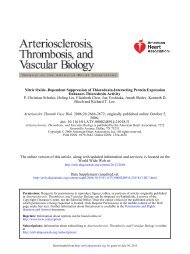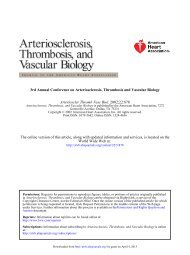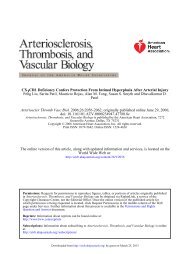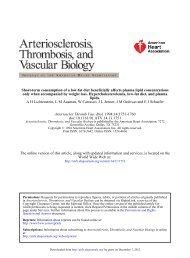Gamma-Glutamyl Transferase Another Biomarker for Metabolic ...
Gamma-Glutamyl Transferase Another Biomarker for Metabolic ...
Gamma-Glutamyl Transferase Another Biomarker for Metabolic ...
Create successful ePaper yourself
Turn your PDF publications into a flip-book with our unique Google optimized e-Paper software.
<strong>Gamma</strong>-<strong>Glutamyl</strong> <strong>Transferase</strong> : <strong>Another</strong> <strong>Biomarker</strong> <strong>for</strong> <strong>Metabolic</strong> Syndrome and<br />
Cardiovascular Risk<br />
Scott M. Grundy<br />
Arterioscler Thromb Vasc Biol. 2007;27:4-7<br />
doi: 10.1161/01.ATV.0000253905.13219.4b<br />
Arteriosclerosis, Thrombosis, and Vascular Biology is published by the American Heart Association, 7272<br />
Greenville Avenue, Dallas, TX 75231<br />
Copyright © 2006 American Heart Association, Inc. All rights reserved.<br />
Print ISSN: 1079-5642. Online ISSN: 1524-4636<br />
The online version of this article, along with updated in<strong>for</strong>mation and services, is located on the<br />
World Wide Web at:<br />
http://atvb.ahajournals.org/content/27/1/4<br />
Permissions: Requests <strong>for</strong> permissions to reproduce figures, tables, or portions of articles originally published<br />
in Arteriosclerosis, Thrombosis, and Vascular Biology can be obtained via RightsLink, a service of the<br />
Copyright Clearance Center, not the Editorial Office. Once the online version of the published article <strong>for</strong><br />
which permission is being requested is located, click Request Permissions in the middle column of the Web<br />
page under Services. Further in<strong>for</strong>mation about this process is available in the Permissions and Rights<br />
Question and Answer document.<br />
Reprints: In<strong>for</strong>mation about reprints can be found online at:<br />
http://www.lww.com/reprints<br />
Subscriptions: In<strong>for</strong>mation about subscribing to Arteriosclerosis, Thrombosis, and Vascular Biology is online<br />
at:<br />
http://atvb.ahajournals.org//subscriptions/<br />
Downloaded from<br />
http://atvb.ahajournals.org/ by guest on November 15, 2012
<strong>Gamma</strong>-<strong>Glutamyl</strong> <strong>Transferase</strong><br />
<strong>Another</strong> <strong>Biomarker</strong> <strong>for</strong> <strong>Metabolic</strong> Syndrome and Cardiovascular Risk<br />
<strong>Gamma</strong>-glutamyl transferase (GGT) is a cell-surface<br />
protein contributing to the extracellular catabolism<br />
of glutathione (GSH). 1 The enzyme is produced in<br />
many tissues, but most GGT in serum is derived from the<br />
liver. 1 In the serum, GGT is carried primarily with lipoproteins<br />
and albumin. 2 Serum levels of GGT are determined by<br />
several factors: alcohol intake, body fat content, plasma<br />
lipid/lipoproteins and glucose levels, and various medications.<br />
1,3,4<br />
See page 127<br />
High levels of GGT have been associated in populations with<br />
increased risk of atherosclerotic cardiovascular disease<br />
(CVD). 5,6 In the current issue of Arteriosclerosis, Thrombosis,<br />
and Vascular Biology, Lee et al7 report that in 3451<br />
Framingham Study participants (mean age 44 years, 52%<br />
women) an increased serum GGT predicted the onset of<br />
metabolic syndrome and the occurrence of CVD and death;<br />
moreover, the highest GGT quartile experienced a 67%<br />
increase in CVD incidence. In this study the association of<br />
GGT concentrations with CVD and mortality remained significant<br />
after adjustment <strong>for</strong> traditional cardiac risk factors<br />
and C-reactive protein (CRP).<br />
One hypothesis <strong>for</strong> the relation of GGT levels and CVD<br />
holds that GGT itself is proatherogenic. 1 GGT has been<br />
reported to occur in atherosclerotic plaques, 8 which might<br />
support this hypothesis. The origins of GGT in plaques could<br />
be through influx of lipoproteins that carry it into lesions. One<br />
of the products of GSH hydrolysis produced by GGT is<br />
cyseinyl-glyceine, which can generate superoxidide anion<br />
radicals through its interaction with free iron. 9 This effect<br />
could promote atherogenesis via LDL oxidation. At present<br />
the postulated pathogenic pathways remain hypothetical and<br />
are yet to be substantiated.<br />
An alternative hypothesis that appears to be consistent with<br />
the findings of Lee et al7 is that elevations of GGT are a<br />
marker of the presence of the metabolic syndrome. Other<br />
workers have reported that high levels of GGT are associated<br />
with fatty liver, insulin resistance, type 2 diabetes, obesity,<br />
and other metabolic risk factors. There is growing evidence<br />
From the Center <strong>for</strong> Human Nutrition and Departments of Clinical<br />
Nutrition and Internal Medicine, University of Texas Southwestern<br />
Medical Center at Dallas.<br />
Correspondence to Scott M. Grundy, Center <strong>for</strong> Human Nutrition and<br />
Departments of Clinical Nutrition and Internal Medicine, University of<br />
Texas Southwestern Medical Center at Dallas, 5323 Harry Hines Boulevard,<br />
Y3.206, Dallas, TX 75390-9052. E-mail scott.grundy@utsouthwestern.edu<br />
(Arterioscler Thromb Vasc Biol. 2007;27:4-7.)<br />
© 2006 American Heart Association, Inc.<br />
Arterioscler Thromb Vasc Biol. is available at http://www.atvbaha.org<br />
DOI: 10.1161/01.ATV.0000253905.13219.4b<br />
Editorial<br />
Scott M. Grundy<br />
that the liver, which is the primary source of circulating GGT,<br />
is a key target organ <strong>for</strong> the development of the metabolic<br />
syndrome. An elevation of GGT is seemingly closely related<br />
to hepatic steatosis 10–13 ; the latter in turn is strongly associated<br />
with the metabolic syndrome. 14–18 The mechanisms<br />
whereby elevated GGT is related to hepatic steatosis have not<br />
been determined, but several possibilities have been proposed<br />
by Ortega et al. 19 For example, fatty liver could cause<br />
hepatocellular damage that would simulate the synthesis of<br />
GGT. Alternatively, excess fat in the liver could enhance<br />
oxidative stress, leading to overconsumption of GSH with a<br />
compensatory increase in GGT synthesis. Finally, a higher<br />
GGT production could be secondary to a low grade hepatic<br />
inflammation induced by hepatic steatosis.<br />
It must be noted that high levels of GGT are not the only<br />
hepatic biomarker of hepatic steatosis. Elevations of transaminase<br />
are common in patients with fatty liver with or without<br />
histological evidence of inflammation. 20–24 In addition,<br />
higher levels of serum transaminases in populations have<br />
been associated with the metabolic syndrome 25–30 and a<br />
higher risk <strong>for</strong> CVD. 31,32<br />
Other lines of evidence support a relationship between<br />
elevated serum GGT and the metabolic syndrome. 33 Thus the<br />
higher GGT levels are accompanied by more insulin resistance<br />
and greater risk <strong>for</strong> developing type 2 diabetes. 34–38<br />
<strong>Another</strong> important association between GGT and the metabolic<br />
syndrome is the finding that higher GGT levels occur in<br />
obese persons, particularly those with abdominal obesity. 39–44<br />
The connection between GGT and the metabolic syndrome<br />
extends to an association of higher GGT levels with hypertension.<br />
45–49 Thus, it appears that all of the major components<br />
of the metabolic syndrome are linked to elevations of serum<br />
GGT.<br />
The metabolic syndrome consists primarily of a group of<br />
atherogenic factors that commonly cluster in individuals. 50<br />
These include elevations of remnant lipoproteins, glucose,<br />
blood pressure, circulating inflammatory cytokines, and prothrombotic<br />
factors and low levels of high density lipoproteins<br />
(HDL) (Table). In addition, a large number of biomarkers<br />
have been reported to be associated with the metabolic<br />
syndrome (Table). These include parameters of obesity and<br />
products released by adipose tissue, plasma insulin levels and<br />
insulin-like growth factors, liver enzymes, C-reactive protein<br />
and circulating metabolites, several components of circulating<br />
lipoproteins, microalbuminuria, and markers of increased<br />
cellular inflammation. 51–66 The status of these biomarkers as<br />
causative factors, either in generation of the metabolic syndrome<br />
or directly in atherogenesis, at present is uncertain.<br />
Some of them have been implicated as causes, but others as<br />
a reflection of a metabolic abnormality.<br />
Downloaded from<br />
http://atvb.ahajournals.org/ 4 by guest on November 15, 2012
Certainly elevations of serum GGT belong on the list of<br />
biomarkers linked to the metabolic syndrome. It appears to be<br />
largely a reflection of ectopic liver fat or secondary hepatic<br />
inflammation. Although high levels of GGT have been<br />
postulated to be directly atherogenic, 1 as have several other<br />
biomarkers <strong>for</strong> the metabolic syndrome, a direct role in<br />
causation of atherosclerosis remains to be determined. Nonetheless,<br />
it is clear that the pathways whereby various biomarkers<br />
are connected to the causation and complications of the<br />
metabolic syndrome represent a rich field <strong>for</strong> future research.<br />
None.<br />
TABLE 1. Atherogenic <strong>Metabolic</strong> Risk Factors and <strong>Biomarker</strong>s <strong>for</strong> the<br />
<strong>Metabolic</strong> Syndrome<br />
Atherogenic <strong>Metabolic</strong> Risk Factors <strong>Metabolic</strong> Syndrome <strong>Biomarker</strong>s<br />
Elevated remnant lipoproteins (50) Waist circumference (50)<br />
Low HDL levels (50) Non-esterified fatty acids (50)<br />
Elevated blood pressure (50) Leptin (53)<br />
Elevated glucose (50) Adiponectin (53)<br />
Elevated cytokines (50, 51)* Resistin (53)<br />
Elevated prothrombotic factors (50, 52)† Angiotensinogen (53)<br />
Insulin (54)<br />
Insulin-like growth factor binding protein-2<br />
(IGFBP-2) (55)<br />
IGF-1 (56)<br />
<strong>Gamma</strong> glutamyl transferase<br />
Transaminases<br />
C-reactive protein (57)<br />
Sialic acid (58)<br />
Uric acid (Salonen) (59)<br />
Ferritin (60, 61)<br />
Ghrelin (62)<br />
Sex hormone-binding globulin (SHBG) (63)<br />
Triglycerides (50)<br />
Apolipoprotein CIII (64)<br />
Small LDL particles (50)<br />
Microalbuminuria (50)<br />
Soluble CD36 (65)<br />
Soluble CD40 ligand (66)<br />
Soluble P-selectin (66)<br />
*Inflammatory cytokines reported to be increased in in the metabolic syndrome include IL-6, IL-10,<br />
IL-18, and TNF alpha.<br />
†A prothromobotic state is characterized by a series of abnormalities that can enhance coagulation,<br />
inhibit fibrinolysis, and alter platelet function, such as increases in plasminogen activator inhibitor-1<br />
(PAI-1), fibrinogen, Factor VII, Factor VIII, Factor X, prothrombin fragments F1�2, and vWF (50).<br />
Disclosures<br />
References<br />
1. Emdin M, Pompella A, Paolicchi A. <strong>Gamma</strong>-glutamyltransferase, atherosclerosis,<br />
and cardiovascular disease: triggering oxidative stress within<br />
the plaque. Circulation. 2005;112:2078–2080.<br />
2. Whitfield JB. <strong>Gamma</strong>-glutamyl transferase. Crit Rev Clin Lab Sci. 2001;<br />
38:263–3553.<br />
3. Brenner H, Rothenbacher D, Arndt V, Schuberth S, Fraisse E, Fliedner<br />
TM. Distribution, determinants, and prognostic value of gamma-<br />
Grundy <strong>Gamma</strong>-<strong>Glutamyl</strong> <strong>Transferase</strong> 5<br />
glutamyltranspeptidase <strong>for</strong> all-cause mortality in a cohort of construction<br />
workers from south Germany. Prev Med. 1997;26:305–310.<br />
4. Nilssen O, Forde OH, Brenn T. The Tromso Study. Distribution and<br />
population determinants of gamma-glutamyltransferase. Am J Epidemiol.<br />
1990;132:318–326.<br />
5. Ruttmann E, Brant LJ, Concin H, Diem G, Rapp K, Ulmer H; Vorarlberg<br />
Health Monitoring and Promotion Program Study Group. <strong>Gamma</strong>glutamyltransferase<br />
as a risk factor <strong>for</strong> cardiovascular disease mortality:<br />
an epidemiological investigation in a cohort of 163,944 Austrian adults.<br />
Circulation. 2005;112:2130–2137.<br />
6. Wannamethee SG, Shaper AG, Lennon L, Whincup PH. Hepatic<br />
enzymes, the metabolic syndrome, and the risk of type 2 diabetes in older<br />
men. Diabetes Care. 2005;28:2913–2918.<br />
7. Lee DS, Evans JC, Robins SJ, Wilson PW, Albano I, Fox CS, Wang TJ,<br />
Benjamin EJ, D’Agostino RB, Vasan RS. <strong>Gamma</strong> glutamyl transferase<br />
and metabolic syndrome, cardiovascular disease, and mortality risk: the<br />
Framingham Heart Study. Arterioscler Thromb Vasc Biol. 2007;27:<br />
127–133.<br />
8. Paolicchi A, Emdin M, Ghliozeni E, Ciancia E, Passino C, Popoff G,<br />
Pompella A. Human atherosclerotic plaques contain gamma-glutamyl<br />
transpeptidase enzyme activity. Circulation. 2004;109:1440.<br />
9. Pompella A, Emdin M, Passino C, Paolicchi A. The significance of serum<br />
-glutamyltransferase in cardiovascular diseases. Clin Chem Lab Med.<br />
2004;42:1085–1091.<br />
10. Ludtke A, Genschel J, Brabant G, Bauditz J, Taupitz M, Koch M,<br />
Wermke W, Worman HJ, Schmidt HH. Hepatic steatosis in<br />
Downloaded from<br />
http://atvb.ahajournals.org/ by guest on November 15, 2012
6 Arterioscler Thromb Vasc Biol. January 2007<br />
Dunnigan-type familial partial lipodystrophy. Am J Gastroenterol. 2005;<br />
100:2218–2224.<br />
11. Angulo P. Nonalcoholic fatty liver disease. N Engl J Med. 2002;346:<br />
1221–1231.<br />
12. Neuschwander-Tetri BA, Caldwell SH. Nonalcoholic steatohepatitis:<br />
summary of an AASLD Single Topic Conference. Hepatology. 2003;37:<br />
1202–1219.<br />
13. Loguercio C, De Simone T, D’Auria MV, de Sio I, Federico A, Tuccillo<br />
C, Abbatecola AM, Del Vecchio Blanco C; Italian AISF Clinical Group.<br />
Non-alcoholic fatty liver disease: a multicentre clinical study by the<br />
Italian Association <strong>for</strong> the Study of the Liver. Dig Liver Dis. 2004;36:<br />
398–405.<br />
14. Collantes RS, Ong JP, Younossi ZM. The metabolic syndrome and<br />
nonalcoholic fatty liver disease. Panminerva Med. 2006;48:41–48.<br />
15. The <strong>Metabolic</strong> Syndrome as a Predictor of Nonalcoholic Fatty Liver<br />
Disease M. Hamaguchi, T. Kojima, N. Takeda, T. Nakagawa, H.<br />
Taniguchi, K. Fujii, T. Omatsu, T. Nakajima, H. Sarui, M. Shimazaki, T.<br />
Kato, J. Okuda and K. Ida. Ann Intern Med. 2005;143:722–728.<br />
16. Browning JD, Szczepaniak LS, Dobbins R, Nuremberg P, Horton JD,<br />
Cohen JC, Grundy SM, Hobbs HH. Related Prevalence of hepatic steatosis<br />
in an urban population in the United States: impact of ethnicity.<br />
Hepatology. 2004;40:1387–1395.<br />
17. Yki-Jarvinen H. Ectopic fat accumulation: an important cause of insulin<br />
resistance in humans. J R Soc Med. 2002;95(Suppl 42):39–45.<br />
18. Ekstedt M, Franzen LE, Mathiesen UL, Thorelius L, Holmqvist M,<br />
Bodemar G, Kechagias S. Long-term follow-up of patients with NAFLD<br />
and elevated liver enzymes. Hepatology. 2006;44:865–873.<br />
19. Ortega E, Koska J, Salbe AD, Tataranni PA, Bunt JC. Related Articles,<br />
Links Serum gamma-glutamyl transpeptidase is a determinant of insulin<br />
resistance independently of adiposity in Pima Indian children. J Clin<br />
Endocrinol Metab. 2006;91:1419–1422.<br />
20. Loguercio C, De Simone T, D’Auria MV, de Sio I, Federico A, Tuccillo<br />
C, Abbatecola AM, Del Vecchio Blanco C; Italian AISF Clinical Group.<br />
Non-alcoholic fatty liver disease: a multicentre clinical study by the<br />
Italian Association <strong>for</strong> the Study of the Liver. Dig Liver Dis. 2004;36:<br />
398–405.<br />
21. Clark JM, Brancati FL, Diehl AM. The prevalence and etiology of<br />
elevated aminotransferase levels in the United States. Am J Gastroenterol.<br />
2003;98:960–967.<br />
22. Fishbein MH, Miner M, Mogren C, Chalekson J. The spectrum of fatty<br />
liver in obese children and the relationship of serum aminotransferases to<br />
severity of steatosis. J Pediatr Gastroenterol Nutr. 2003;36:54–61.<br />
23. Daniel S, Ben-Menachem T, Vasudevan G, Ma CK, Blumenkehl M.<br />
Prospective evaluation of unexplained chronic liver transaminase abnormalities<br />
in asymptomatic and symptomatic patients. Am J Gastroenterol.<br />
1999;94:3010–3014.<br />
24. Sorbi D, Boynton J, Lindor KD. The ratio of aspartate aminotransferase<br />
to alanine aminotransferase: potential value in differentiating nonalcoholic<br />
steatohepatitis from alcoholic liver disease. Am J Gastroenterol.<br />
1999;94:1018–1022.<br />
25. Su CC, Wang K, Hsia TL, Chen CS, Tung TH. Association of nonalcoholic<br />
fatty liver disease with abnormal aminotransferase and postprandial<br />
hyperglycemia. J Clin Gastroenterol. 2006;40:551–554.<br />
26. Kazumi T, Kawaguchi A, Hirano T, Yoshino G. Serum alanine aminotransferase<br />
is associated with serum adiponectin, C-reactive protein and<br />
apolipoprotein B in young healthy men. Horm Metab Res. 2006;38:<br />
119–124.<br />
27. Kazumi T, Kawaguchi A, Hirano T, Yoshino G. Serum alanine aminotransferase<br />
is associated with serum adiponectin, C-reactive protein and<br />
apolipoprotein B in young healthy men. Horm Metab Res. 2006;38:<br />
119–124.<br />
28. Onat A, Hergenc G, Karabulut A, Turkmen S, Dogan Y, Uyarel H, Can<br />
G, Sansoy V. Serum gamma glutamyltransferase as a marker of metabolic<br />
syndrome and coronary disease likelihood in nondiabetic middle-aged<br />
and elderly adults. Prev Med. 2006;43:136–139.<br />
29. Choi KM, Lee KW, Kim HY, Seo JA, Kim SG, Kim NH, Choi DS, Baik<br />
SH. Association among serum ferritin, alanine aminotransferase levels,<br />
and metabolic syndrome in Korean postmenopausal women. Metabolism.<br />
2005;54:1510–1514.<br />
30. Hanley AJ, Williams K, Festa A, Wagenknecht LE, D’Agostino RB Jr,<br />
Haffner SM. Liver markers and development of the metabolic syndrome:<br />
the insulin resistance atherosclerosis study. Diabetes. 2005;54:<br />
3140–3147.<br />
31. Bouter LM, Stehouwer CD, Heine RJ, Diamant M. Alanine aminotransferase<br />
predicts coronary heart disease events: A 10-year follow-up of the<br />
Hoorn Study. Atherosclerosis. In press.<br />
32. Ioannou GN, Weiss NS, Boyko EJ, Mozaffarian D, Lee SP. Elevated<br />
serum alanine aminotransferase activity and calculated risk of coronary<br />
heart disease in the United States. Hepatology. 2006;43:1145–1151.<br />
33. Rantala AO, Lilja M, Kauma H, Savolainen MJ, Reunanen A, Kesaniemi<br />
YA. <strong>Gamma</strong>-glutamyl transpeptidase and the metabolic syndrome.<br />
J Intern Med. 2000;248:230–238.<br />
34. Andre P, Balkau B, Born C, Charles MA, Eschwege E; D.E.S.I.R. study<br />
group. Three-year increase of gamma-glutamyltransferase level and<br />
development of type 2.diabetes in middle-aged men and women: the<br />
D.E.S.I.R. cohort. Diabetologia. 2006;49:2599–2603.<br />
35. Marchesini G, Avagnina S, Barantani EG, Ciccarone AM, Corica F,<br />
Dall’Aglio E, Dalle Grave R, Morpurgo PS, Tomasi F, Vitacolonna E.<br />
Aminotransferase and gamma-glutamyltranspeptidase levels in obesity<br />
are associated with insulin resistance and the metabolic syndrome. J<br />
Endocrinol Invest. 2005;28:333–339.<br />
36. Thamer C, Tschritter O, Haap M, Shirkavand F, Machann J, Fritsche A,<br />
Schick F, Haring H, Stumvoll M. Elevated serum GGT concentrations<br />
predict reduced insulin sensitivity and increased intrahepatic lipids. Horm<br />
Metab Res. 2005;37:246–251.<br />
37. Lee DH, Silventoinen K, Jacobs DR Jr, Jousilahti P, Tuomileto J. gamma-<br />
<strong>Glutamyl</strong>transferase, obesity, and the risk of type 2 diabetes: observational<br />
cohort study among 20,158 middle-aged men and women. J Clin<br />
Endocrinol Metab. 2004;89:5410–5414.<br />
38. Nakanishi N, Nishina K, Li W, Sato M, Suzuki K, Tatara K. Serum<br />
gamma-glutamyltransferase and development of impaired fasting glucose<br />
or type 2 diabetes in middle-aged Japanese men. J Intern Med. 2003;254:<br />
287–295.<br />
39. Lawlor DA, Sattar N, Smith GD, Ebrahim S. The associations of physical<br />
activity and adiposity with alanine aminotransferase and gammaglutamyltransferase.<br />
Am J Epidemiol. 2005;161:1081–1088.<br />
40. Li TC, Liu CS, Lin CC. The relationship of liver enzyme abnormalities<br />
and obesity in Aboriginal children in Taiwan. J Gastroenterol. 2004;39:<br />
1170–1174.<br />
41. Choi JW. Association between elevated serum hepatic enzyme activity<br />
and total body fat in obese humans. Ann Clin Lab Sci. 2003;33:257–264.<br />
42. Nakanishi N, Nakamura K, Suzuki K, Tatara K. Lifestyle and serum<br />
gamma-glutamyltransferase: a study of middle-aged Japanese men.<br />
Occup Med (Lond). 2000;50:115–120.<br />
43. Ikai E, Noborizaka Y, Tsuritani I, Honda R, Ishizaki M, Yamada Y.<br />
Serum gamma-glutamyl transpeptidase levels and hypertension in nondrinkers:<br />
a possible role of fatty liver in the pathogenesis of obesity<br />
related hypertension. Obes Res. 1993;1:469–474.<br />
44. Robinson D, Whitehead TP. Effect of body mass and other factors on<br />
serum liver enzyme levels in men attending <strong>for</strong> well population screening.<br />
Ann Clin Biochem. 1989 ;26(Pt 5):393–400.<br />
45. Stranges S, Trevisan M, Dorn JM, Dmochowski J, Donahue RP. Body fat<br />
distribution, liver enzymes, and risk of hypertension: evidence from the<br />
Western New York Study. Hypertension. 2005;46:1186–1193. Epub<br />
2005 Oct 3.<br />
46. Lee DH, Jacobs DR Jr, Gross M, Steffes M. Serum gammaglutamyltransferase<br />
was differently associated with microalbuminuria by<br />
status of hypertension or diabetes: the Coronary Artery Risk Development<br />
in Young Adults (CARDIA) Study. Clin Chem. 2005;51:<br />
1185–1191.<br />
47. Lee DH, Ha MH, Kim KY, Jin DG, Jacobs DR Jr. <strong>Gamma</strong>glutamyltransferase:<br />
an effect modifier in the association between age and<br />
hypertension in a 4-year follow-up study. J Hum Hypertens. 2004;18:<br />
803–807.<br />
48. Lee DH, Jacobs DR Jr, Gross M, Kiefe CI, Roseman J, Lewis CE, Steffes<br />
M. <strong>Gamma</strong>-glutamyltransferase is a predictor of incident diabetes and<br />
hypertension: the Coronary Artery Risk Development in Young Adults<br />
(CARDIA) Study. Clin Chem. 2003;49:1358–1366.<br />
49. Ikai E, Honda R, Yamada Y. Serum gamma-glutamyl transpeptidase level<br />
and blood pressure in nondrinkers: a possible pathogenetic role of fatty<br />
liver in obesity-related hypertension. J Hum Hypertens. 1994;8:95–100.<br />
50. Grundy SM, Cleeman JI, Daniels SR, Donato KA, Eckel RH, Franklin<br />
BA, Gordon DJ, Krauss RM, Savage PJ, Smith SC Jr, Spertus JA, Costa<br />
F; Am Heart Association; National Heart, Lung, and Blood Institute.<br />
Related Articles, Links Diagnosis and management of the metabolic<br />
syndrome: an Am Heart Association/National Heart, Lung, and Blood<br />
Institute Scientific Statement. Circulation. 2005;112:2735–2752.<br />
Downloaded from<br />
http://atvb.ahajournals.org/ by guest on November 15, 2012
51. Tracy RP. Inflammation, the metabolic syndrome and cardiovascular risk.<br />
Int J Clin Pract Suppl. 2003;134:10–17.<br />
52. Palomo I, Alarcon M, Moore-Carrasco R, Argiles JM. Hemostasis alterations<br />
in metabolic syndrome (review). Int J Mol Med. 2006;18:969–974.<br />
53. Trayhurn P. Endocrine and signalling role of adipose tissue: new perspectives<br />
on fat. Acta Physiol Scand. 2005;184:285–293.<br />
54. Reaven GM. Insulin resistance, the insulin resistance syndrome, and<br />
cardiovascular disease. Panminerva Med. 2005;47:201–210.<br />
55. Heald AH, Kaushal K, Siddals KW, Rudenski AS, Anderson SG, Gibson<br />
JM. Insulin-like growth factor binding protein-2 (IGFBP-2) is a marker<br />
<strong>for</strong> the metabolic syndrome. Exp Clin Endocrinol Diabetes. 2006;114:<br />
371–376.<br />
56. Sesti G, Sciacqua A, Cardellini M, Marini MA, Maio R, Vatrano M,<br />
Succurro E, Lauro R, Federici M, Perticone F. Plasma concentration of<br />
IGF-I is independently associated with insulin sensitivity in subjects with<br />
different degrees of glucose tolerance. Diabetes Care. 2005;28:120–125.<br />
57. Ridker PM, Wilson PW, Grundy SM. Related Articles, Links Should<br />
C-reactive protein be added to metabolic syndrome and to assessment of<br />
global cardiovascular risk? Circulation. 2004;109:2818–2825.<br />
58. Browning LM, Jebb SA, Mishra GD, Cooke JH, O’Connell MA, Crook<br />
MA, Krebs JD. Elevated sialic acid, but not CRP, predicts features of the<br />
metabolic syndrome independently of BMI in women. Int J Obes Relat<br />
Metab Disord. 2004;28:1004–1010.<br />
59. Salonen JT. Uric acid level as a risk factor <strong>for</strong> cardiovascular and<br />
all-cause mortality in middle-aged men: a prospective cohort study. Arch<br />
Intern Med. 2004;164:1546–1551.<br />
Grundy <strong>Gamma</strong>-<strong>Glutamyl</strong> <strong>Transferase</strong> 7<br />
60. Gonzalez AS, Guerrero DB, Soto MB, Diaz SP, Martinez-Olmos M,<br />
Vidal O. <strong>Metabolic</strong> syndrome, insulin resistance and the inflammation<br />
markers C-reactive protein and ferritin. Eur J Clin Nutr. 2006;60:<br />
802–809.<br />
61. Jehn M, Clark JM, Guallar E. Serum ferritin and risk of the metabolic<br />
syndrome in U.S. adults. Diabetes Care. 2004;27:2422–2428.<br />
62. Glintborg D, Andersen M, Hagen C, Frystyk J, Hulstrom V, Flyvbjerg A,<br />
Hermann AP. Evaluation of metabolic risk markers in polycystic ovary<br />
syndrome (PCOS). Adiponectin, ghrelin, leptin and body composition in<br />
hirsute PCOS patients and controls. Eur J Endocrinol. 2006;155:<br />
337–345.<br />
63. Lewis JG, Shand BI, Elder PA, Scott RS. Plasma sex hormone-binding<br />
globulin rather than corticosteroid-binding globulin is a marker of insulin<br />
resistance in obese adult males. Diabetes Obes Metab. 2004;6:259–263.<br />
64. Olivieri O, Bassi A, Stranieri C, Trabetti E, Martinelli N, Pizzolo F,<br />
Girelli D, Friso S, Pignatti PF, Corrocher R. Apolipoprotein C-III, metabolic<br />
syndrome, and risk of coronary artery disease. J Lipid Res. 2003;<br />
44:2374–2378.<br />
65. Handberg A, Levin K, Hojlund K, Beck-Nielsen H. Identification of the<br />
oxidized low-density lipoprotein scavenger receptor CD36 in plasma: a<br />
novel marker of insulin resistance. Circulation. 2006;114:1169–1176.<br />
66. Gokulakrishnan K, Deepa R, Mohan V, Gross MD. Soluble P-selectin<br />
and CD40L levels in subjects with prediabetes, diabetes mellitus, and<br />
metabolic syndrome–the Chennai Urban Rural Epidemiology Study. Metabolism.<br />
2006;55:237–242.<br />
Downloaded from<br />
http://atvb.ahajournals.org/ by guest on November 15, 2012














